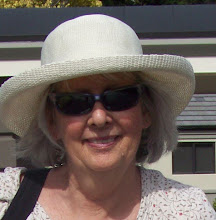
This is the painting I like best from the ones I did last week in my sister's studio in Arizona. It is called "Autumn on the Blue" and it is from a photo I took of the Blue River in Summit County, Colorado. Of course, tomorrow my favorite could be a different one, but it will probably have fall color in it! Indian Yellow is one of my most used colors of paint. Adding white to any color cools it and makes it chalky. Adding Indian Yellow warms it right up again but as it is transparent, it doesn't change values or opacity. I can't paint Colorado landscapes with aspen and cottonwoods in the fall without Indian Yellow! It gives a much nicer color than mixing any of the oranges or reds that I have tried to mix with Cad Yellow.
My palette is pretty limited, intentionally. Perhaps it is time I started trying a few other colors as well. I usually have a warm and a cool of each primary, plus white and Burnt Umber (and Indian Yellow!) My sister swears by Permanent Rose, so I guess I should give it a try one day.
Every time I attend a workshop, I always make sure I have all the colors on the materials list, but I find I still continue to use the ones I am used to. Mixing is easier when you know what you are going to get! Then again, visit Karin Jurick's blog and watch the video of her laying out her palette. It takes about 5 or 6 minutes and she uses about 50 different colors. Ahh, to paint like Karin Jurick!! Do you think if I buy all the colors she uses I will paint like her? I wish it were that easy.....







